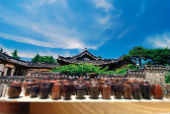View this article in another language
- 한국어
- English
- 日本語
- 中文
- العربية
- Español
- Français
- Deutsch
- Pусский
- Tiếng Việt
- Indonesian
*This is the second part in our series, “Onggi, traditional earthenware vessel in Korea.”
Korean cuisine and traditional pottery
Across East Asia and elsewhere in the world, most families' main staple is rice, and in Korea it's joined with the triumvirate of the Korean kitchen: soy sauce, hot pepper paste and brown bean paste. These three popular condiments, or additives, are made from the soy bean, the pepper plant and the brown bean and all require fermentation for a period of time. Indeed, there is a saying in Korean that, "The taste of the food is the taste of the fermentation process."
When families prepare their fermented condiments or additives, they put a lot of effort into putting their love into the food. Furthermore, they have the inherited wisdom and knowledge of how to prepare the condiments, accumulated experience passed down through the ages.
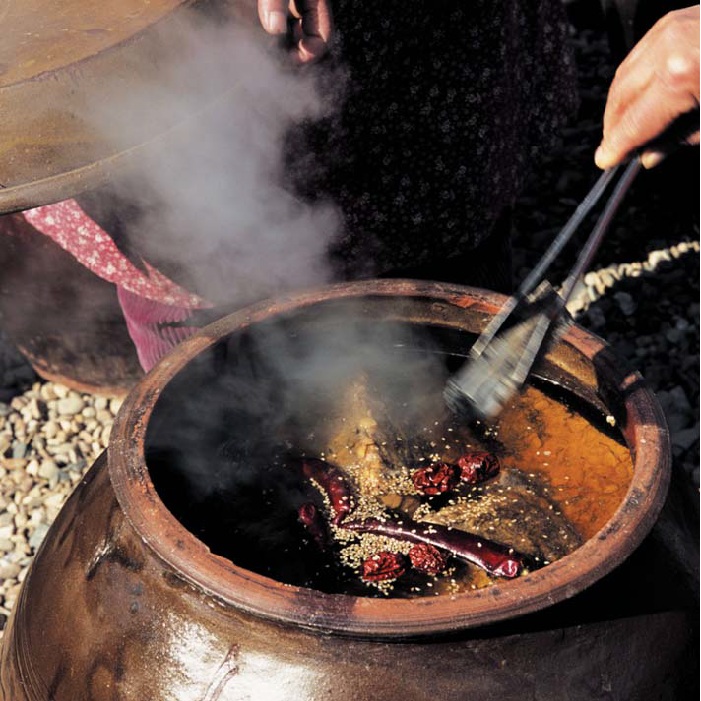
When preparing or storing the fermented ingredients, the chef has to use the properly shaped urn for the proper foodstuffs. Also, the cooking and preparation is traditionally done on particularly auspicious days in the lunar calendar. For example, a traditionally auspicious day on which to prepare many of the fermented foodstuffs is the so-called Day of the Horse in the first lunar month of the year. Traditionalists also believe that if foodstuffs are prepared on the Day of the Monkey in the tenth lunar month, the food will go sour. Similarly, if they are prepared on the Day of the Snake, also in the tenth lunar month, the food will be infested with maggots. To alleviate such superstitions, on the day of preparation the traditional chef will offer a sacrifice to the spirits with a piece of soybean malt, some red peppers and salt, placing it all on a small table and praying for a successful endeavor. When the family members come together to prepare their fermented condiments or additives, they do so with the utmost care, since the health of the entire beloved family is at stake, as they will eat the fermented condiments with every meal.
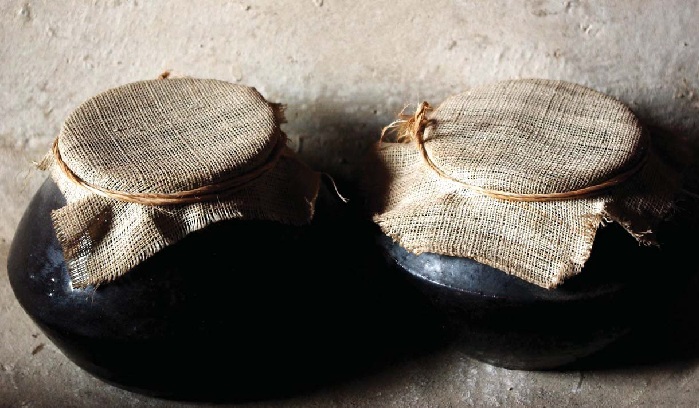
The annals of history do not tell us exactly when ancient peoples of the Korean Peninsula began fermenting their foods. According to the Samgukji Wijidongijeon (the 삼국지 위지 동이전, or 三國志 魏志 東夷傳), an ancient Chinese text, it is recorded that during the Goguryeo Kingdom (37 B.C.-A.D. 668), people began to prepare and enjoy fermented foods. There are also murals inside ancient royal tombs from the Goguryeo from around the 3rd century that show the use of deep wells and of various earthenware urns.
Thus, we have a trickling of evidence showing that humans have been using fermentation to store their foodstuffs for at least one thousand years. Times change, influences come and go, and a variety of new culinary aspects enter and leave the peninsula's cuisine. Yet, people continue to prepare soy sauce, hot pepper paste and brown bean paste, as they've done since time immemorial, giving them food throughout the winter. The changes in lifestyle come with modernity, electricity and plastics. Nowadays, fermented condiments or additives can be kept in specialized refrigerators, dubbed "kimchi refrigerators" in honor of Korean cuisine's most common form of fermented and peppered vegetable. Go back a few decades, however, and homes had terraced areas on the roof or on the front porch for the aging and storage of a variety of fermented foodstuffs, each at a different stage in the overall preparation process. That is why the "breathing pottery," or onggi in Korean, were such essential items in the Korean home.
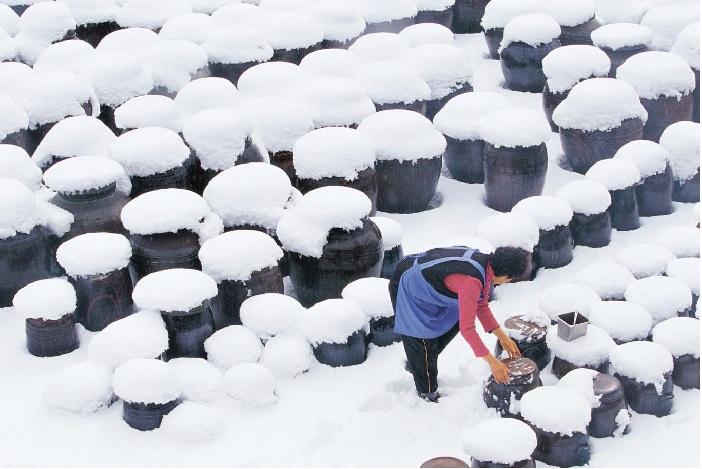
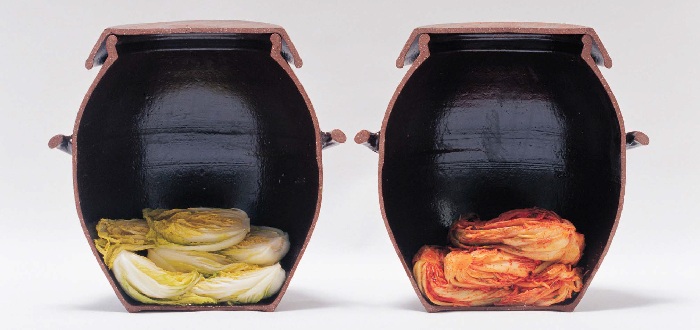
The usage of traditional urns
Large earthenware pottery urns are used in many different ways, from storing fermented ingredients through to storing a variety of seasonings and pre-prepared cooked or steamed foods. They had a place in traditional cuisine and housekeeping, as the center of a family's diet, and at the same time play a role in modern cuisine and in the modern household. Each style of urn has its own name, depending on its size, usage and how it was made.
The largest of the earthenware pots are called dok. They are used for fermenting the three pillars of the Korean table: soy sauce, hot pepper paste and brown bean paste.
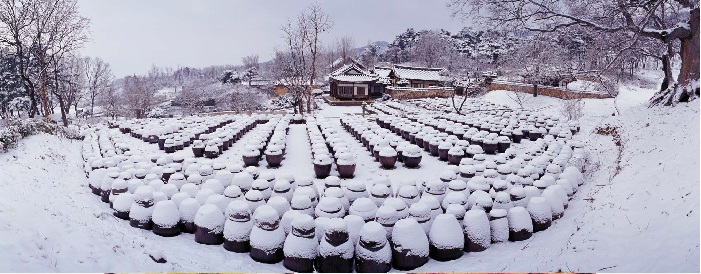
The small earthenware pots are called danji. They are usually used to store the same three seasonings and their ingredients: soy sauce, hot pepper paste and brown bean paste.
The "kimchi dok" is the largest of earthenware pottery urns and is used to prepare the whole range of fermented vegetables needed to get a family through the winter. They will be buried underground or partially underground for aging and storing until the spring thaw arrives. During the spring and summer, smaller kimchi urns are used, so-called "kimchi danji."
There are also round earthenware bowls used at the table to serve soup or stew.
Alcohol can also be made in traditional large urns, which are ideal for fermenting grain or fruit. Earthenware pottery is, in fact, ideal for brewing grains and even for distillation, giving us the soju gori. Ceramics were also used to make the containers used to move soju, the suljanggun and even for the serving bottles, the sulbyeong.
Pottery was also used in the kitchen. Small bowls or pots became containers for salt, red pepper powder or sesame seed powder. Glazed or unglazed cauldrons were used to cook rice. The steamer used to heat up and to soften rice cake was generally unglazed. The water jugs, the containers for the cutlery and the kettles were also generally made out of pottery.
Many ordinary household items were made of earthenware pottery, including braziers, lanterns, ash trays, portable urinals, spittoons and pieces for Chinese chess. Even some calligraphy equipment was made out of earthenware, such as small bottles for the ink, the ink stone itself, the brush holder, the wash bowl for the brush and the paper weight.
With the onset of rapid modernization, traditions stretching back thousands of years, traditions that created and supported the ancient family home, have suddenly disappeared from daily life.
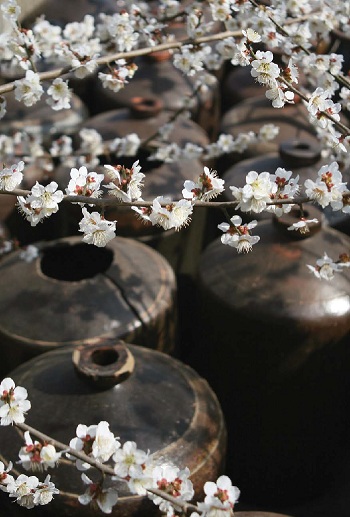
Since the 1970s, plastic, glass and metal containers were introduced. A more globalized cuisine slowly made inroads, as people traveled and learned about the world. People now lived in glass and steel urban environments, with office schedules and factory line shifts. This grand shift in humanity discouraged reliance on traditionally prepared fermented condiments and additives, leading to a reduction in the common household's use of pottery urns.
Traditional pottery has not become extinct, however. Traditional onggi pots are still used and the processes and traditions of fermentation are maintained in many seasoning factories, at an industrial scale, and in many traditional restaurants, on a more humane scale. There are efforts underway to recover a healthier method of preparing food, as awareness of the natural environment has grown alongside GDP. The modern urban household now takes its food quite seriously and expects certain standards when it comes to the fermented seasonings one consumes on a daily basis. As Korean cuisine continues its path toward the future, the three core elements of soy sauce, hot pepper paste and brown bean paste remain at the center of the family and at the center of the home.
*This series of article has been made possible through the cooperation of the National Research Institute of Cultural Heritage. (Source: Intangible Cultural Heritage of Korea)
Korean cuisine and traditional pottery
Across East Asia and elsewhere in the world, most families' main staple is rice, and in Korea it's joined with the triumvirate of the Korean kitchen: soy sauce, hot pepper paste and brown bean paste. These three popular condiments, or additives, are made from the soy bean, the pepper plant and the brown bean and all require fermentation for a period of time. Indeed, there is a saying in Korean that, "The taste of the food is the taste of the fermentation process."
When families prepare their fermented condiments or additives, they put a lot of effort into putting their love into the food. Furthermore, they have the inherited wisdom and knowledge of how to prepare the condiments, accumulated experience passed down through the ages.

Soy sauce being prepared in a traditional urn is purified with hot charcoal.
When preparing or storing the fermented ingredients, the chef has to use the properly shaped urn for the proper foodstuffs. Also, the cooking and preparation is traditionally done on particularly auspicious days in the lunar calendar. For example, a traditionally auspicious day on which to prepare many of the fermented foodstuffs is the so-called Day of the Horse in the first lunar month of the year. Traditionalists also believe that if foodstuffs are prepared on the Day of the Monkey in the tenth lunar month, the food will go sour. Similarly, if they are prepared on the Day of the Snake, also in the tenth lunar month, the food will be infested with maggots. To alleviate such superstitions, on the day of preparation the traditional chef will offer a sacrifice to the spirits with a piece of soybean malt, some red peppers and salt, placing it all on a small table and praying for a successful endeavor. When the family members come together to prepare their fermented condiments or additives, they do so with the utmost care, since the health of the entire beloved family is at stake, as they will eat the fermented condiments with every meal.

Medicinal urns are used to make herbal and traditional medicines.
The annals of history do not tell us exactly when ancient peoples of the Korean Peninsula began fermenting their foods. According to the Samgukji Wijidongijeon (the 삼국지 위지 동이전, or 三國志 魏志 東夷傳), an ancient Chinese text, it is recorded that during the Goguryeo Kingdom (37 B.C.-A.D. 668), people began to prepare and enjoy fermented foods. There are also murals inside ancient royal tombs from the Goguryeo from around the 3rd century that show the use of deep wells and of various earthenware urns.
Thus, we have a trickling of evidence showing that humans have been using fermentation to store their foodstuffs for at least one thousand years. Times change, influences come and go, and a variety of new culinary aspects enter and leave the peninsula's cuisine. Yet, people continue to prepare soy sauce, hot pepper paste and brown bean paste, as they've done since time immemorial, giving them food throughout the winter. The changes in lifestyle come with modernity, electricity and plastics. Nowadays, fermented condiments or additives can be kept in specialized refrigerators, dubbed "kimchi refrigerators" in honor of Korean cuisine's most common form of fermented and peppered vegetable. Go back a few decades, however, and homes had terraced areas on the roof or on the front porch for the aging and storage of a variety of fermented foodstuffs, each at a different stage in the overall preparation process. That is why the "breathing pottery," or onggi in Korean, were such essential items in the Korean home.

A winter scene of traditional urns, covered in snow, storing a variety of fermented and fermenting foods.

A cross-section of a traditional urn filled with cabbage, both before and after applying the pepper, in preparation for the winter.
The usage of traditional urns
Large earthenware pottery urns are used in many different ways, from storing fermented ingredients through to storing a variety of seasonings and pre-prepared cooked or steamed foods. They had a place in traditional cuisine and housekeeping, as the center of a family's diet, and at the same time play a role in modern cuisine and in the modern household. Each style of urn has its own name, depending on its size, usage and how it was made.
The largest of the earthenware pots are called dok. They are used for fermenting the three pillars of the Korean table: soy sauce, hot pepper paste and brown bean paste.

A traditional winter scene shows a field of urns and crocks, all storing food for the winter, on the terraces of a traditional home in Nonsan, Chungcheongnam-do.
The small earthenware pots are called danji. They are usually used to store the same three seasonings and their ingredients: soy sauce, hot pepper paste and brown bean paste.
The "kimchi dok" is the largest of earthenware pottery urns and is used to prepare the whole range of fermented vegetables needed to get a family through the winter. They will be buried underground or partially underground for aging and storing until the spring thaw arrives. During the spring and summer, smaller kimchi urns are used, so-called "kimchi danji."
There are also round earthenware bowls used at the table to serve soup or stew.
Alcohol can also be made in traditional large urns, which are ideal for fermenting grain or fruit. Earthenware pottery is, in fact, ideal for brewing grains and even for distillation, giving us the soju gori. Ceramics were also used to make the containers used to move soju, the suljanggun and even for the serving bottles, the sulbyeong.
Pottery was also used in the kitchen. Small bowls or pots became containers for salt, red pepper powder or sesame seed powder. Glazed or unglazed cauldrons were used to cook rice. The steamer used to heat up and to soften rice cake was generally unglazed. The water jugs, the containers for the cutlery and the kettles were also generally made out of pottery.
Many ordinary household items were made of earthenware pottery, including braziers, lanterns, ash trays, portable urinals, spittoons and pieces for Chinese chess. Even some calligraphy equipment was made out of earthenware, such as small bottles for the ink, the ink stone itself, the brush holder, the wash bowl for the brush and the paper weight.
With the onset of rapid modernization, traditions stretching back thousands of years, traditions that created and supported the ancient family home, have suddenly disappeared from daily life.

A series of traditional urns are stored underneath the cherry blossoms.
Since the 1970s, plastic, glass and metal containers were introduced. A more globalized cuisine slowly made inroads, as people traveled and learned about the world. People now lived in glass and steel urban environments, with office schedules and factory line shifts. This grand shift in humanity discouraged reliance on traditionally prepared fermented condiments and additives, leading to a reduction in the common household's use of pottery urns.
Traditional pottery has not become extinct, however. Traditional onggi pots are still used and the processes and traditions of fermentation are maintained in many seasoning factories, at an industrial scale, and in many traditional restaurants, on a more humane scale. There are efforts underway to recover a healthier method of preparing food, as awareness of the natural environment has grown alongside GDP. The modern urban household now takes its food quite seriously and expects certain standards when it comes to the fermented seasonings one consumes on a daily basis. As Korean cuisine continues its path toward the future, the three core elements of soy sauce, hot pepper paste and brown bean paste remain at the center of the family and at the center of the home.
*This series of article has been made possible through the cooperation of the National Research Institute of Cultural Heritage. (Source: Intangible Cultural Heritage of Korea)
